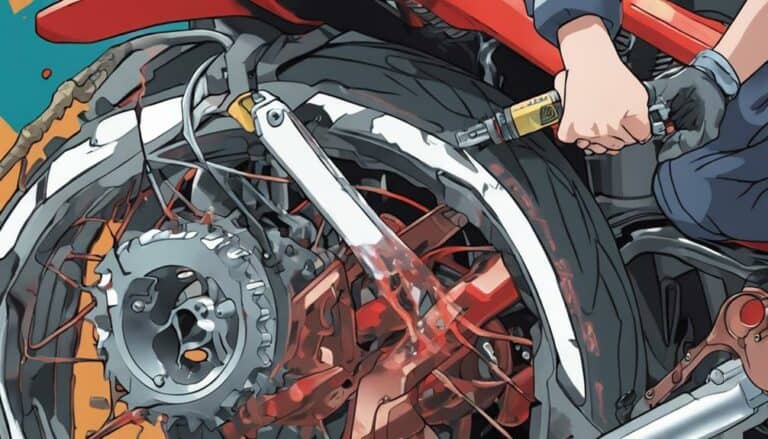If you've been hesitant to tackle bleeding the rear brakes on your dirt bike due to concerns about complexity, fear not. The process of bleeding the rear brakes may seem intimidating at first, but with the right guidance and a systematic approach, you'll find it to be a manageable task.
From preparing the necessary tools to ensuring proper bleeding technique, mastering this skill is essential for maintaining your bike's safety and performance. Stay tuned to discover the step-by-step process that will help you achieve excellent brake efficiency and responsiveness in no time.
Key Takeaways
- Elevate the dirt bike for rear wheel access.
- Securely attach clear hose to bleed screw.
- Pump brake pedal slowly with ring spanner.
- Troubleshoot spongy brakes with re-bleeding and checks.
Preparing the Necessary Tools
Gather the required tools for bleeding the rear brakes on your dirt bike, including a ring spanner, brake fluid, a catch container, and a clean rag. Make sure to have the correct type of brake fluid suitable for your dirt bike to guarantee proper brake function. The first thing to do is to hold the brake while loosening the bleed screw with the ring spanner. This step is essential to prevent air from entering the brake system during the bleeding process.
Having a catch container in place is necessary to collect the old brake fluid that will be expelled as you bleed the brakes. This helps maintain cleanliness and prevents the old fluid from spilling onto other parts of the bike. Additionally, keeping a clean rag nearby allows you to wipe away any excess brake fluid that may drip while working on the rear brake system.
Elevating the Rear of the Bike
Elevate the rear of your dirt bike using a stand or suitable support to facilitate easy access to the brake components. Ensuring stability and security of the bike is important before commencing the bleeding process to prevent accidents.
Lifting the rear wheel off the ground allows for smooth wheel rotation while bleeding the brake system. It's essential to exercise caution when elevating the bike to prevent damage to any parts and avoid tipping over during the process.
- Use a reliable stand or support designed for dirt bikes.
- Check the stability of the bike before lifting it.
- Make sure the rear wheel is off the ground for free rotation.
- Be careful to prevent any damage to the bike or parts.
Elevating the rear of the dirt bike provides you with better access to the brake caliper and bleed screw, making the bleeding procedure more manageable and successful.
Removing the Brake Reservoir Cover
To proceed with the brake bleeding process on your dirt bike, the next step involves removing the brake reservoir cover located near the rear brake master cylinder. When removing the cover, use a suitable tool like a screwdriver or socket wrench to unfasten the screws or bolts securing it. Gently lift off the reservoir cover to access the brake fluid reservoir. Be cautious not to spill brake fluid to maintain cleanliness in the brake system. It's essential to check the fluid level and inspect the condition of the fluid in the reservoir before proceeding with bleeding the rear brakes. Here is a table summarizing key points for this step:
| Key Steps | Details |
|---|---|
| Checking fluid level | Inspect the brake fluid level |
| Cleaning reservoir | Ensure the reservoir is clean |
| Avoiding spills | Be careful not to spill brake fluid |
Attaching the Bleeder Hose
Securely attach the bleeder hose to the rear brake caliper's bleed screw guaranteeing a tight connection for efficient fluid drainage. Here's how to properly attach the bleeder hose:
- Hose connection: Make sure the hose is securely attached to the bleed screw to prevent any air from entering the brake system.
- Fluid monitoring: Opt for a clear hose to easily monitor the fluid and detect any air bubbles during the bleeding process.
- Leak prevention: Tighten the hose connection properly to prevent any leaks that could compromise the efficiency of the bleeding process.
- Positioning: Ensure the hose is long enough to reach a container to catch the brake fluid and position it in a way that allows easy access to the bleed screw while bleeding the rear brakes.
Pumping and Bleeding the Brakes
Attach the ring spanner to the bleed screw before proceeding with the pumping and bleeding process for the rear brakes on your dirt bike.
When pumping the brake pedal, do it slowly and steadily to avoid forcing air back into the system.
Make sure you use the recommended brake fluid choice for your bike to maintain peak brake function.
Common mistakes to avoid include over-tightening the bleed screw, which can damage it, and letting the brake fluid reservoir run dry during the bleeding process, introducing more air into the system.
If you encounter spongy brakes even after bleeding, try troubleshooting by re-bleeding the brakes, checking for any leaks in the system, or inspecting the brake lines for any kinks or blockages.
Conclusion
To summarize, ensuring peak brake performance on your dirt bike involves a meticulous process of bleeding the rear brakes.
By following the steps outlined in this article, you can eliminate any air bubbles in the brake system, resulting in improved brake responsiveness and effectiveness.
Remember, giving your brakes a little attention can go a long way in enhancing your riding experience.

